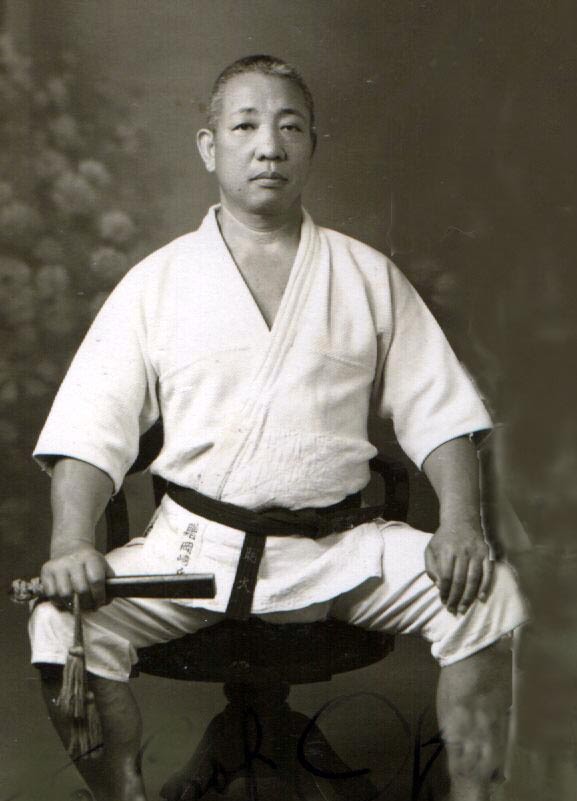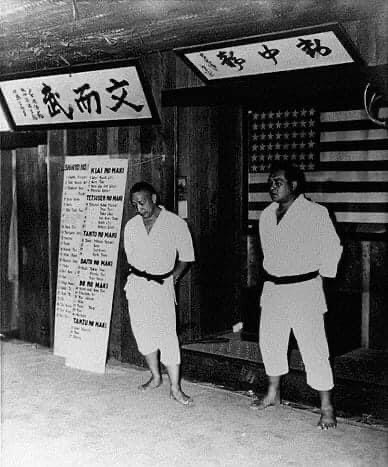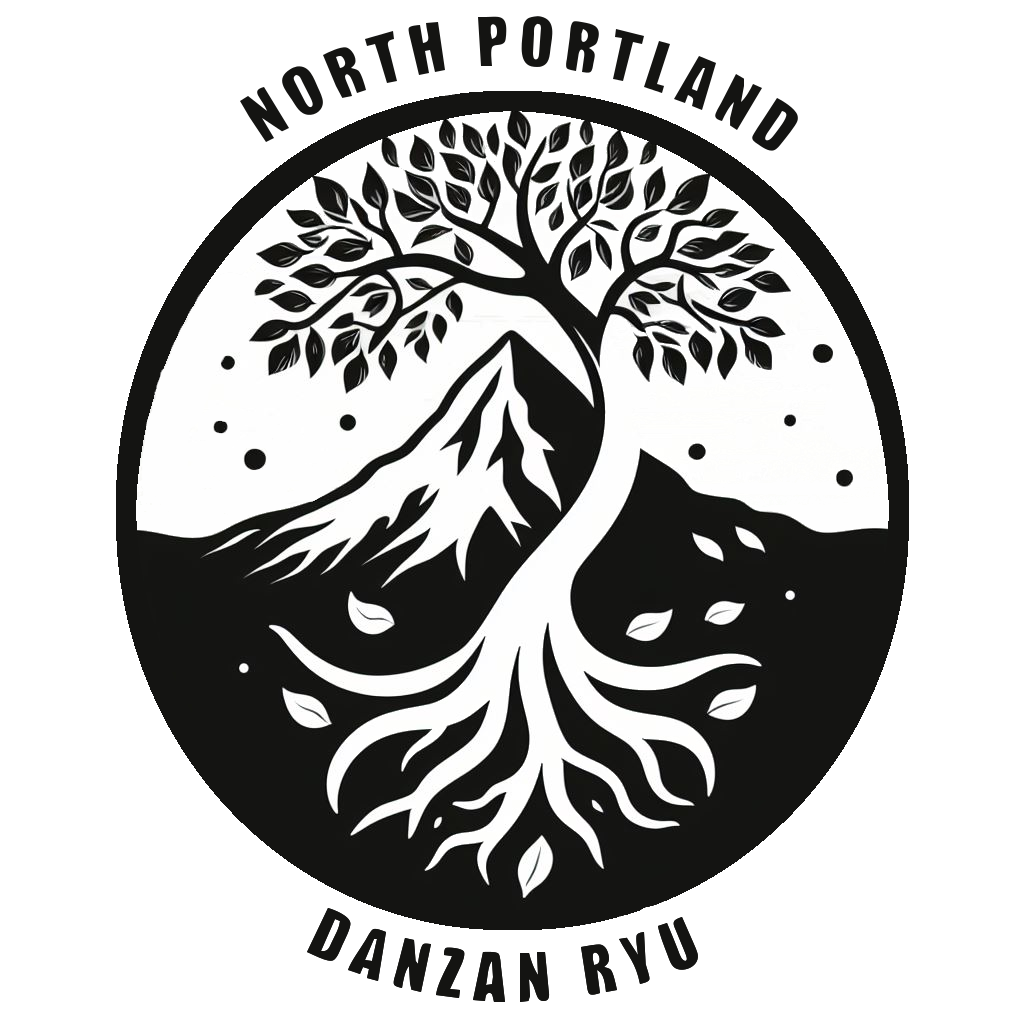Danzan Ryu
Danzan-Ryu Jujitsu is a system of jujitsu developed in Hawaii by Professor Henry Seishiro Okazaki in the early 1900s. Danzan-Ryu is a system of traditional Japanese Jujutsu combined with techniques from Okinawan Karate, Chinese Kung-Fu, Hawaiian Lua, Filipino Escrima or Kali, and Western Boxing and Folk Wrestling.
Danzan-Ryu includes escapes from holds and pins, joint-locking techniques, throws, sweeps, chokes, striking, and traditional restoration methods and healing arts. At higher levels, students are instructed in the use of some traditional weapons such as the tessen (iron fan).
History
Professor Henry Seishiro Okazaki
Professor Okazaki was born in 1890 in Fukushima Prefecture, Honshu, Japan. In 1906, he emigrated to Hilo, Hawaii where he worked in the sugarcane plantations. Around 1909, Professor Okazaki was diagnosed with a respiratory illness believed to be tuberculosis. Looking for a way to recover his health, he began to study Yoshin-Ryu Jujutsu at the Shinyu Kai Dojo under Yoshimatsu Tanaka. In his own words, Professor Okazaki “started to practice Jujitsu in earnest and in defiance of death.” Professor Okazaki credited this training with his recovery, and decided to devote himself to the study, practice, and instruction of jujutsu.
To that end, Professor Okazaki continued to train in various schools of jujutsu including the Igawa-Ryu and Kosogabe-Ryu, and cross-trained in other martial arts such as Okinawan Karate, Kung-Fu, Hawaiian Lua, Escrima, Folk Wrestling, and Boxing. Professor Okazaki took what he learned from these arts and blended them together into the system of jujitsu that he named “Danzan-Ryu.”
In addition to his martial training, Professor Okazaki studied traditional massage and restoration techniques (seifukujitsu), and gained a reputation as a healer. In 1929, Professor Okazaki opened the Nikko Sanatorium of Restoration Massage in Honolulu, which is still in operation today. Many famous personalities of the times came to the Sanatorium to meet, be taught by, or be treated by Professor Okazaki.
Professor Okazaki taught seifukujitsu to all of his students in order to balance their fighting spirit with their healing spirit. His belief was that a martial artist should be able to heal as well as harm.
Alongside the Nikko Sanitorium, Professor Okazaki established the Kodenkan (School of Ancient Tradition) where he taught Danzan-Ryu. The name Kodenkan also signifies the responsibility of senior students to help junior students along the path of Danzan-Ryu. He opened his doors to anyone who wanted to learn, believing that everyone should be able to learn jujitsu regardless of their heritage.
Professor Okazaki continued to teach Danzan-Ryu and Seifukujitsu until his death in 1951.

The American Judo & Jujitsu Federation
In the late 1940’s, four of Professor Okazaki’s students (Professors Ray Law, Bud Estes, Richard Rickerts, and John Cahill) came to the mainland and founded the American Judo and Jujitsu Federation (AJJF). One of Professor Okazaki’s dreams was to have a Danzan-Ryu dojo in every state of the Union. Over the years, the AJJF has helped make that dream a reality. Currently, there are AJJF affiliated Danzan-Ryu dojos in nineteen States within the U.S.

Esoteric Principles
Since the fundamental principle acquired through the practice of Jujitsu has been elevated to a finer moral concept called Judo, “The Way of Gentleness,” it may well be said that the primary objective of practicing Judo is perfection of character. And to perfect one’s character one must be grateful for the abundant blessings of Heaven, Earth, and Nature, as well as for the great love of parents; one must realize his enormous debt to teachers and be ever mindful of his obligations to the general public.
As a member of a family, one’s first duty is to be filial to parents, to be helpful and harmonious with one’s wife or husband, and to be affectionate to brothers and sisters, so that the family may be a sound, successful, and harmonious unit of the community.
As a member of a nation one must be grateful for the protection which one derives as a citizen; one must guard against self-interest and foster a spirit of social service. One must be discreet in action, yet hold courage in high regard, and strive to cultivate manliness. One must be gentle, modest, polite, and resourceful; never eccentric, but striving always to practice moderation in all things. One must realize that these qualities constitute the secret of the practice of Judo.
Anyone who practices Judo should neither be afraid of the strong nor despise the weak; nor should he act contrary to the strength of his enemy because of the art he has acquired. For example, when a boat is set afloat on water, one man’s strength is sufficient to move the boat back and forth. This is only possible because the boat floats; for if, on the other hand, the boat is placed on dry land, the same man’s strength is scarcely sufficient to move it. It is necessary, therefore, that the weak should learn this fact with regard to the strong.
The forms and techniques should be remembered as the basic art of Judo. One should never use these arts against anyone without sufficient justification. Therefore, refrain from arrogance and do not despise a small enemy or a weak opponent. Every student of Judo should realize that honesty is the foundation of all virtues. Kindness is the secret of business prosperity. Amiability is the essence of success. Working pleasantly is the mother of health. Strenuous effort and diligence conquer adverse circumstances. Simplicity, fortitude, and manliness are the keys to joy and gladness; and service to humanity is the fountain of mutual existence and common prosperity.
As aptly expressed in the poem “The boughs that bear most hang lowest,” one should never forget the virtue of modesty as one attains proficiency in the art of Judo. Do not disdain or regard lightly either literary or military art; each is important and deserves equal cultivation and respect. Within constant motion and change there is tranquillity; and within tranquillity, there is motion and change.
Remember always parental love and one’s enormous indebtedness to teachers. Be grateful for the protection of Heaven and Earth. Be a good leader to younger men. To lead younger men well, will in the long run, mean to attain proficiency in the skill of Judo.
Like a drawing in India ink of the whispering of wind in the pines, the secrets of Judo can only be suggested. Only through personal experience can one comprehend the mystic ecstasy of such secrets. It is said of Jujitsu that it would require ten years of practice to win victory over one’s self and twenty years to win victory over others.
Whatever the trials or dangers, even “Hell under the upraised sword,” remain calm and remember the doctrine imparted to you by your teacher.
A noted verse reads: “For the lotus flower to fall is to rise to the surface.”
Only by cultivating a receptive state of mind, without preconceived ideas or thoughts, can one master the secret art of reacting spontaneously and naturally without hesitation and without purposeless resistance.
These are the secrets of Kodenkan into which I have had the honor to initiate you.

Henry Seishiro Okazaki
Master (Danzan Ryu)
Director of the Kodenkan (Dojo)

